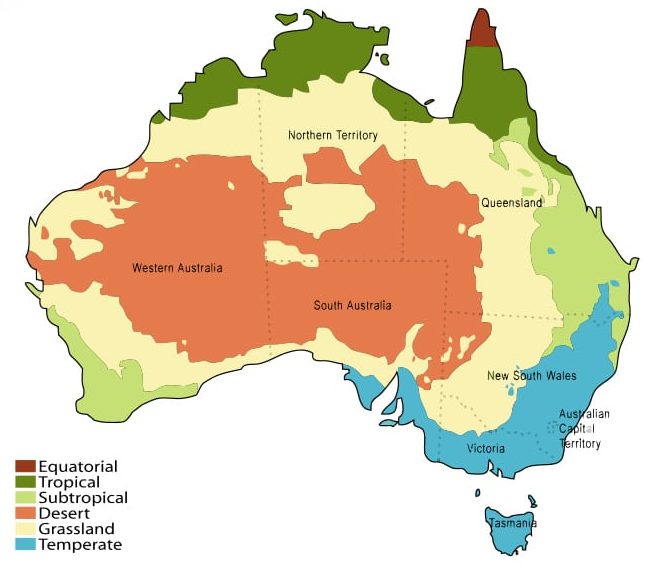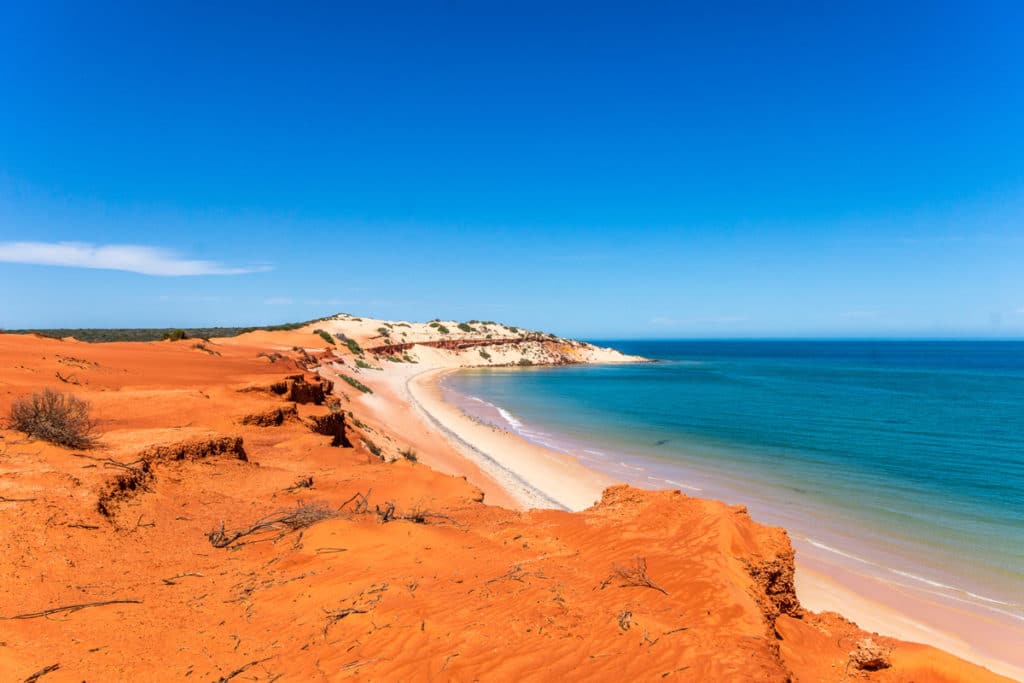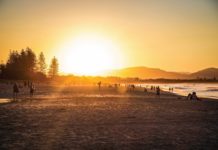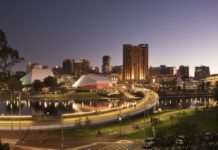
Australia is a huge country with a wide variety of climates. Therefore, depending on the season, you can undertake various types of trips and activities. You just have to know which regions are best at which time of the year! In this article, we provide an overview of the different climate zones and seasons in Australia. With this in mind, you will know when to visit Australia and can plan to be in the right place at the right time. And for anyone planning to do some fruit picking on their trip, our guide will help you figure out the best season to find a job.
Table of Contents
Australia’s climate and seasons
Australia being in the southern hemisphere means the seasons are reversed compared to the northern hemisphere. Here, Christmas is celebrated in summer, with good weather and pretty high temperatures!
The south of Australia has four seasons, while the tropical north has only two distinct seasons: one is wet and the other dry.
The entire northern part of Australia (northern Western Australia, Northern Territory and Queensland) enjoys a tropical climate. During the dry season, from April to September, temperatures are hot and the weather is dry. On the other hand, when the wet season comes, from October to March, the heat is humid, the weather is stormy and often accompanied by very heavy rain.
In the southern part of the country (southern Western Australia, South Australia, Victoria, Tasmania and New South Wales), the climate is temperate and oceanic. Spring runs from September to November and summer from December to February. Autumn is from March to May, then winter from June to August.
Finally, in the central region of the country, an arid climate prevails. Rainfall is rare. The coolest time of year is between March and August. The hottest period is between September and February, when the temperatures can be stiflingly high. Be careful though, because the nights are always cold.
Australia climate zones explained
| Zone | Regions | Characteristics |
|---|---|---|
| Tropical | Far North QLD (Cairns), NT | Wet (Oct–Apr) & Dry (May–Sept) seasons; high humidity. |
| Subtropical | East Coast (Brisbane, Sydney) | Hot, humid summers; mild, drier winters. |
| Temperate | SE Australia (Melbourne, Adelaide) | Four distinct seasons; moderate rainfall year-round. |
| Mediterranean | SW WA (Perth) | Hot, dry summers; cool, wet winters. |
| Desert/Outback | Central Australia | Extreme heat by day, cold nights; < 250 mm annual rain. |

Climates in Australia’s major cities
Weather in Sydney
Sydney is located in the southern, and therefore temperate, part of the country. The city experiences hot summers and mild winters. The hottest month is January and the coldest is July. The climate in Sydney is therefore pleasant all year round.
Best period to visit: September to February
Climate: Mild climate throughout the year with no dry season and high rainfall
Average yearly temperature: 19.5 degrees
| Month | Jan | Feb | Mar | Apr | May | June | Jul | Aug | Sep | Oct | Nov | Dec |
|---|---|---|---|---|---|---|---|---|---|---|---|---|
| Min (°C) | 19 | 20 | 18 | 15 | 12 | 9 | 8 | 9 | 11 | 14 | 16 | 18 |
| Max (°C) | 27 | 27 | 25 | 23 | 20 | 18 | 17 | 19 | 21 | 23 | 24 | 26 |
| Best period |
Weather in Melbourne
Melbourne is located in Port Phillip Bay. The ocean allows for an oceanic and temperate climate. Weather in Melbourne can be very unpredictable at times. People often say that Melbourne experiences “four seasons in a day”. It could be very hot in the morning, then a few hours later the temperature could drop by 10°C and it could suddenly start raining!
Best period: October to April
Climate: Temperate coastal climate with no dry season and average rainfall
Average yearly temperature: 14 degrees
| Month | Jan | Feb | Mar | Apr | May | June | Jul | Aug | Sep | Oct | Nov | Dec |
|---|---|---|---|---|---|---|---|---|---|---|---|---|
| Min (°C) | 14 | 14 | 13 | 10 | 8 | 6 | 5 | 6 | 7 | 8 | 10 | 12 |
| Max (°C) | 26 | 27 | 24 | 20 | 17 | 14 | 13 | 15 | 17 | 19 | 22 | 24 |
| Best period |
Weather in Perth
The capital of Western Australia, Perth is located in southwestern Australia. With a temperate and dry climate, this city is pleasant to live in all year round. The summers are hot, with sometimes extreme temperature spikes. Perth is less humid than the east coast at this latitude.
Best period: October to May
Climate: Warm Mediterranean climate with a dry summer
Average yearly temperature: 18.3 degrees
| Month | Jan | Feb | Mar | Apr | May | June | Jul | Aug | Sep | Oct | Nov | Dec |
| Min (°C) | 18 | 18 | 17 | 14 | 10 | 9 | 8 | 8 | 9 | 12 | 14 | 16 |
| Max (°C) | 31 | 32 | 30 | 26 | 22 | 19 | 18 | 19 | 20 | 23 | 27 | 29 |
| Best period |
Weather in Adelaide
Located in the southeastern part of the country, Adelaide enjoys a mild climate all year round. Like other cities in South Australia, it experiences four seasons. In midsummer, the UV is high so be sure to protect your skin from the sun. Mid-winter is cold (it freezes for a few weeks) and rainy. Beware of the southern chill and don’t forget your sunscreen all year round; the ozone layer is non-existent there. Australia has the highest skin cancer rate in the world.
Best time: Mid seasons – March to May / October, November
Climate: Warm Mediterranean climate with a dry summer and cool winter months.
Average yearly temperature: 17 degrees
| Month | Jan | Feb | Mar | Apr | May | June | Jul | Aug | Sep | Oct | Nov | Dec |
| Min (°C) | 17 | 17 | 15 | 12 | 10 | 8 | 7 | 8 | 10 | 11 | 14 | 15 |
| Max (°C) | 29 | 29 | 26 | 23 | 19 | 16 | 15 | 17 | 19 | 22 | 25 | 27 |
| Best period |
Weather in Hobart
The island of Tasmania, south of mainland Australia, is not to be missed. Although its temperatures are cool almost all year round, the city of Hobart is worth a visit. The best time to visit is when temperatures are highest, in late January. For lovers of cool temperatures, Hobart’s chilly, snowy winters will delight you.
| Month | Jan | Feb | Mar | Apr | May | June | Jul | Aug | Sep | Oct | Nov | Dec |
| Min (°C) | 17 | 17 | 15 | 12 | 10 | 8 | 7 | 8 | 10 | 11 | 14 | 15 |
| Max (°C) | 13 | 13 | 11 | 9 | 8 | 5 | 5 | 6 | 7 | 8 | 10 | 11 |
Weather in Darwin
The capital of the Northern Territory, Darwin is “the place to be” during the Australian winter. The north of the country is renowned for its tropical and humid climate. It is hot, humid summers are nevertheless a challenge to get through without air conditioning. Ten minutes of walking outside in summer in Darwin and you’ll be covered in sweat! If you are not drenched enough, the wet season (November to April) will take care of that for you.
Best time: May to October
Climate: Two distinct seasons; a wet (Nov-April) and a dry season (May-Oct) however, the temperature remains warm all year round.
Average yearly temperature: 27.2 degrees
| Month | Jan | Feb | Mar | Apr | May | June | Jul | Aug | Sep | Oct | Nov | Dec |
| Min (°C) | 32 | 32 | 32 | 33 | 32 | 31 | 31 | 32 | 33 | 33 | 33 | 15 |
| Max (°C) | 25 | 25 | 25 | 24 | 22 | 20 | 19 | 20 | 23 | 25 | 26 | 26 |
| Best period |
Cairns – average temperatures
Located in the tropical region of Australia, Cairns has only two seasons. The dry season extends from May to October. This period is pleasant and warm. The wet season, from December to March, includes hot days and daily thunderstorms.
Best time: May to October
Climate: Dry winter with mild-warm climate and a wet summer with hot and humid conditions
Average yearly temperature: 24 degrees
| Month | Jan | Feb | Mar | Apr | May | Jun | Jul | Aug | Sep | Oct | Nov | Dec |
|---|---|---|---|---|---|---|---|---|---|---|---|---|
| Min (°C) | 24 | 24 | 23 | 22 | 20 | 18 | 17 | 18 | 19 | 21 | 23 | 24 |
| Max (°C) | 31 | 31 | 31 | 29 | 28 | 26 | 26 | 27 | 28 | 30 | 31 | 32 |
| Best period |
Alice Springs – average temperatures
In central Australia and the arid parts of Australia, temperatures are cold in the winter months and hot in summer. The peculiarity of the climate of the red centre is its cold summer nights. It can be very hot in summer in these desert areas so remember to protect yourself and drink water regularly.
Best time: January to April and October to December
Climate: Humid and warm subtropical.
Average yearly temperature: 21.3 degrees
| Month | Jan | Feb | Mar | Apr | May | Jun | Jul | Aug | Sep | Oct | Nov | Dec |
|---|---|---|---|---|---|---|---|---|---|---|---|---|
| Min (°C) | 22 | 21 | 18 | 13 | 8 | 5 | 4 | 6 | 11 | 15 | 18 | 21 |
| Max (°C) | 37 | 36 | 33 | 29 | 24 | 20 | 20 | 23 | 28 | 31 | 34 | 36 |
| Best period |
Source: www.bom.gov.au
For more information on real-time weather, visit the Australian Government website.

Regional Tips by Season
| Region | Best Season | Notes |
|---|---|---|
| Great Barrier Reef | Jun–Oct | Clear waters, lower stinger risk, calm seas. |
| Red Centre (Uluru) | Apr–May, Sept | Mild days (20–30 °C), avoid summer heat. |
| Tasmania | Dec–Mar | Warmest months (15–25 °C), ideal for hiking. |
| Coastal NSW/VIC | Sep–Nov, Mar–May | Shoulder seasons for mild weather and fewer crowds. |
| Kimberley & Arnhem | May–Sept | True dry season; dusty but sunny. |
On your road trips in Australia, follow the sun! Start with the South of the country in spring and summer. Then, the North and the Center are recommended in autumn and winter.
🚐 Road Trip itineraries in Australia
All the most popular road trip routes in Australia. Information and advice on the best times to go, spots to visit and the budget you’ll need.
When is the best time of year to visit Australia?
Australia’s climate remains relatively mild throughout the year for travellers. Nevertheless, Australia is a huge country and some weather variations are to be expected depending on the states. To avoid some of Mother Nature’s surprises and to optimise your trip, here is a little help.
The following breakdown of the seasons is a quick guide on the best time to visit Australia and where you should go when:
🌸 Spring – September to November
Average temperature is between 20 and 37 degrees.
The period between September and October is favourable for the whole country, with a mild climate – except for the north where October brings the rainy season.
☀️ Summer – December to February
Average temperature is between 20 and 37 degrees.
Summer is the best time to visit the south and Tasmania – but it is also the busiest tourist period! Remember to book your excursions, your hotel and your vehicle in advance. In the centre and the north, the weather is not as good. The Outback experiences very high, even unbearable temperatures, while the North can experience impressive rainfall.
🍂 Autumn – March to May
Average temperature is between 17 and 35 degrees.
Autumn offers reasonable temperatures throughout the country. The rainy season in the North gradually ends. This is generally a good time to visit both the Outback and the outer reaches of the country.
❄️ Winter – June to August
Average temperatures range from 11 degrees (south) to 30 degrees (north).
Because of its mild temperatures, winter is the best time to visit the North of the country. It is also the best time to see the Great Barrier Reef. The weather is sunny, the water is clear and the risk of jellyfish is very low (more likely to occur from December to March). In the South, however, the weather is rather rainy with low temperatures.
🚐 5% Discount on your Rental with Travellers Autobarn
Enjoy 5% OFF on your rental with Travellers Autobarn using Promo Code GUIDEEN
Natural Hazards
Australia’s wide-ranging climate brings not only spectacular landscapes but also significant natural hazards:
- Bushfires & Drought
- The 2019–20 “Black Summer” fires burned over 24 million hectares, devastated koala populations and drove new national fire management policies.
- Since then, fire seasons have started earlier and ended later. Prolonged droughts—made worse by climate change—have fuelled hotter, drier conditions across eastern and southern Australia.
- Severe Storms & Flooding
- Intense East Coast lows and “rain bomb” events have caused record-breaking floods in Queensland and NSW (notably in 2022 and 2024), with flash floods closing highways and isolating communities.
- Hailstorms in major cities like Brisbane and Melbourne in 2023 inflicted millions in property damage.
- Tropical Cyclones
- Northern Australia remains prone to cyclones every summer (Nov–Apr). Since Cyclone Tracy (Darwin, 1974), more recent storms—e.g., Cyclone Seroja (WA, 2021) and Cyclone Kirrily (NT/QLD, 2023) and Alfred (QLD, 2024) have reinforced the need for improved early-warning systems and building codes.
- Heatwaves & UV Exposure
- Australia endures some of the world’s highest UV indices year-round. Recent heatwaves in 2023 reached 50 °C in inland towns, prompting public health alerts and strict water restrictions.
👍 Key Advice
- Flood season: Jan–Mar along the east coast
- Bushfire season: Aug–Mar in southern and eastern states
- Cyclone season: Nov–Apr in northern regions
Travel & Packing Advice
- Check BOM Alerts: Always consult the Bureau of Meteorology for fire danger, flood warnings and cyclone updates
- Layer Up: Desert nights can dip below 5 °C in winter; bring warm layers.
- Sun Protection: UV index is high year-round—hat, sunscreen, sunglasses mandatory.
- Hydration: Carry 3–4 L water per person per day in remote areas.
- Road Access: During the northern wet season, some roads may close—plan detours.
- Farm / work clothes: you may end up working on a farm at some point if you want to stay in Australia for a second and/or third year. For this you will need appropriate clothing, such as reflective vests, safety shoes, gloves and other workwear. These can usually be purchased at Kmart or BigW.
Read also : Pack your bag for Australia
Jobs and activities According to the seasons in Australia
The climatic diversity of Australia allows you to enjoy a multitude of different excursions and activities throughout the year.
Australian winter will allow you to enjoy the aurora borealis in Tasmania or in southern Victoria. Seeing the snow in a country so famous for its warmth is also a unique experience. You may be able to see it in the two states mentioned above, as well as in the mountains of New South Wales (Mount Kosciuszko).
If you want to see whales, dolphins, sharks, and other marine animals, follow their migration patterns. Whales are usually spotted in winter (June to September). You can find them off the coasts of Perth, Adelaide, Sydney and Brisbane. You can also observe them from May to July and from September to December in Tasmania.
What would Australia be without surfing? You can enjoy its magnificent beaches all year round. Beware, however, of the crocodiles in the North and the sharks found everywhere else. Each state is renowned for its surf spots, except the Northern Territory.
If you can, split up your farm work, starting in South Australia in the summer and ending in the North in the winter. That way you will find a good compromise, to avoid suffocating from the heat in summer and freezing in winter.
2025 Climate Trends
- Record Heat: The 2024–25 summer was Australia’s 2nd-hottest on record (1.89 °C above long-term average)
- Extreme Spring: Spring 2025 averaged 2.08 °C above norms—the hottest spring ever
- Longer Fire Seasons & Marine Heatwaves: Climate change is lengthening fire seasons and warming oceans, increasing coral bleaching risks
- ENSO & IOD Outlook: Current El Niño–Southern Oscillation is neutral, but Indian Ocean Dipole is trending negative, suggesting slightly wetter winter rains in WA and SA
FAQs
🕕 What about jet lag in Australia?
In Australia, there are three different time zones throughout the country.
- GMT + 8h in Western Australia (Western Australia)
- GMT + 9:30 in the Northern Territory and South Australia (South Australia)
- GMT + 10h for the rest of the states (Queensland, Tasmania, territory of Canberra or ACT, New South Wales and Victoria).
Note that Australia changes time during the summer season EXCEPT in certain territories: Queensland, NT and WA.
🏄♀️ What are the best places to surf in Australia?
The best spots for surfing in Australia are divided between the states of Queensland, Western Australia and New South Wales. You can obviously find cool surf spots in other states, but the most famous ones are here, including the beaches of Byron Bay (NSW), Noosa (QLD), the Gold Coast (QLD), Exmouth (WA) and Broome (WA). It’s up to you to choose your destination according to the climate and the seasons!
Take a look at our article listing the 10 best surf spots in Australia.
🚶♀️ What are the best places to hike in Australia?
If you’re a fan of hiking, you’re in luck, because Australia is full of incredible trails and walking tracks suitable for different fitness levels. You can find amazing hikes throughout the country but if we had to choose, we would recommend the following states:
- NSW (Bondi Beach to Coogee Beach, the Blue Mountains…)
- NT (Ormiston Gorge, Larapinta Trail, Uluru, Kings Canyon, Trephina Gorge…)
- TAS (Mount Wellington, Organ Pipes, Freycinet National Park, Three Capes Track, Overland Track, Cradle Mountain, Bay of Fires…).
If you are traveling through the other states, here are some places that are also worth a visit!
- VIC (Great Ocean Road)
- WA (Cape to Cape Track)
- SA (Flinder Ranges, Murray River…).
As with surfing, it’s up to you to choose which destination to visit depending on the weather.
🍓 Should we really rely on the seasons to find work in the harvest?
The answer is yes! Each state has its own planting and therefore harvesting seasons. Outside of these times of the year, it is pretty pointless to look for picking/packing work because you won’t find any. The ripening of fruits and vegetables is directly related to the weather and climate. However, you may still be able to find a job on a farm. Before or after the harvest periods, a few actions are necessary to prepare the trees for the next season, including planting seeds and pruning (which is done just before the harvest and which consists of unloading the trees of the smallest fruits, which will allow the others to grow properly. You may also have to do some weeding. In short, there should be plenty of work to be found!


























